-
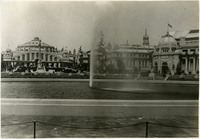 McCarthy Album 08, Photograph 123
McCarthy Album 08, Photograph 123 No Caption: View of the Government Building, neighboring buildings, and Geyser Basin at the Alaska-Yukon-Pacific Exposition. Held in Seattle to celebrate the development of the Pacific Northwest, the fair attracted 3.7 million visitors over the course of its run from June to October 1909. Although most of the fair's buildings have since been destroyed, several of them now serve as part of the University of Washington campus. For instance, Geyser Basin became Drumheller Fountain, now at a slightly different location.
-
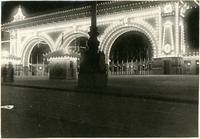 McCarthy Album 08, Photograph 122
McCarthy Album 08, Photograph 122 No Caption: Entryway to the Alaska-Yukon-Pacific Exposition as seen at night. Held in Seattle to celebrate the development of the Pacific Northwest, the fair attracted 3.7 million visitors over the course of its run from June to October 1909. Although most of the fair's buildings have since been destroyed, several of them now serve as part of the University of Washington campus.
-
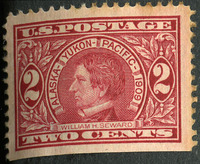 McCarthy Album 08, Photograph 121b
McCarthy Album 08, Photograph 121b No Caption: Commemorative U.S. two-cent postage stamp issued for the Alaska-Yukon-Pacific Exposition. The stamp features a portrait of William H. Seward, U.S. Secretary of State (1861-1869), U.S. Senator (1849-1861), and twelfth governor of New York (1839-1842). Seward negotiated the purchase of the Alaskan territory from Russia in 1867.
-
 McCarthy Album 08, Photograph 121a
McCarthy Album 08, Photograph 121a No Caption: Yellow ribbon commemorating "San Francisco Day" at the Alaska-Yukon-Pacific Exposition. Held in Seattle to celebrate the development of the Pacific Northwest, the fair attracted 3.7 million visitors over the course of its run from June to October 1909. Although most of the fair's buildings have since been destroyed, several of them now serve as part of the University of Washington campus.
-
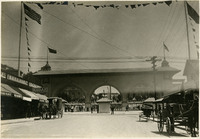 McCarthy Album 08, Photograph 121
McCarthy Album 08, Photograph 121 No Caption: View of the entryway to the Alaska-Yukon-Pacific Exposition. Held in Seattle to celebrate the development of the Pacific Northwest, the fair attracted 3.7 million visitors over the course of its run from June to October 1909. Although most of the fair's buildings have since been destroyed, several of them now serve as part of the University of Washington campus.
-
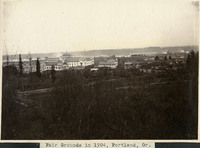 McCarthy Album 08, Photograph 120
McCarthy Album 08, Photograph 120 Caption: "Fair Grounds in 1904, Portland, Or." Bird's eye view of the fair grounds in Portland, Oregon.
-
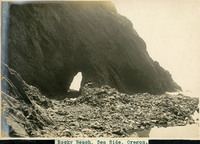 McCarthy Album 08, Photograph 119
McCarthy Album 08, Photograph 119 Caption: "Rocky Beach, Sea Side, Oregon.," undated. View of a rocky cliff along a beach in Oregon, with a tunnel carved out by wave action and rubble at the base of the cliff.
-
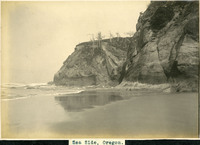 McCarthy Album 08, Photograph 118
McCarthy Album 08, Photograph 118 Caption: "Sea Side, Oregon.," undated. View of a beach along the Oregon coastline, with a rocky cliffs and ocean waves breaking.
-
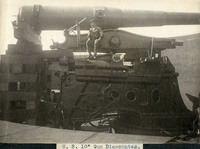 McCarthy Album 08, Photograph 117
McCarthy Album 08, Photograph 117 Caption: "U.S. 10" Gun Dismounted.," c. 1905. View from the side of a 10" disappearing gun, a heavy coastal artillery weapon. It has been dismounted from its carriage, with one end held up by timbers. An unidentified man is seated near the barrel of the gun.
-
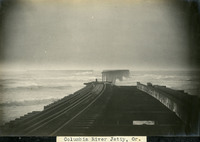 McCarthy Album 08, Photograph 116
McCarthy Album 08, Photograph 116 Caption: "Columbia River Jetty, Or.," c. 1905. View of a dilapidated jetty that once carried railroad tracks. Portions of the jetty appear to have been destroyed or washed away.
-
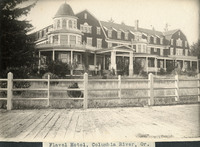 McCarthy Album 08, Photograph 115
McCarthy Album 08, Photograph 115 Caption: "Flavel Hotel, Columbia River, Or.," c. 1909. Built at the turn of the century, the Flavel Hotel housed passengers waiting to board steamships of the Great Northern Pacific Steamship Company bound for San Francisco and other ports. The Flavel family constructed the hotel as part of an effort to establish the town of Flavel on Tansy Point along the Columbia River. The town failed to attract sufficient residents, however, and was annexed into Warrenton by 1918. By the time this photograph was taken, the hotel appears to have been abandoned.
-
 McCarthy Album 08, Photograph 114
McCarthy Album 08, Photograph 114 Caption: "Ferry Boat Tacoma on the Columbia River.," c. 1905. View of the railroad ferry Tacoma, with a train on board. The Tacoma operated from 1884 until 1908, when a railroad bridge was constructed across the Columbia connecting Portland, Oregon with points north of the river.
-
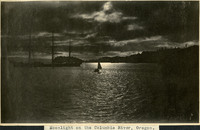 McCarthy Album 08, Photograph 113
McCarthy Album 08, Photograph 113 Caption: "Moonlight on the Columbia River, Oregon.," c. 1905. Photograph of the Columbia River at night. A cloudy sky nearly obscures the moon, but allows enough light to see a three-masted schooner and a small sailboat on the river.
-
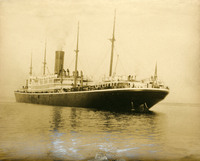 McCarthy Album 08, Photograph 112
McCarthy Album 08, Photograph 112 No Caption: c. 1909. View of the steamship Minnesota II, built in 1903. She was said to be the largest U.S. merchant ship afloat at the time. Operated by the Great Northern Steamship Company, she sailed between the U.S. and markets in Asia until 1915 when she was sold. In 1917 the Minnesota II began operating in the Atlantic between the U.S. and the United Kingdom. The U.S. Navy commissioned her as a troop ship in 1919, changing her name to Troy. She brought over 14,000 U.S. troops home from war-torn Europe. She never resumed active service after this, being scrapped in 1923.
-
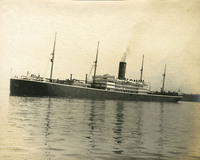 McCarthy Album 08, Photograph 111
McCarthy Album 08, Photograph 111 Caption: "Steamer Minnesota, Seattle.," c. 1909. View of the steamship Minnesota II, built in 1903. She was said to be the largest U.S. merchant ship afloat at the time. Operated by the Great Northern Steamship Company, she sailed between the U.S. and markets in Asia until 1915. She was sold at that time, and in 1917 began operating in the Atlantic between the U.S. and the United Kingdom. The U.S. Navy commissioned her as a troop ship in 1919, changing her name to Troy. She brought over 14,000 U.S. troops home from war-torn Europe. She never resumed active service after this, being scrapped in 1923. See also 96-07-08-alb08-166.
-
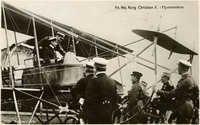 McCarthy Album 08, Photograph 110
McCarthy Album 08, Photograph 110 Caption: "Hs. Maj. Kong Christian X. i Flyvemaskine" and "100 Kobenhavn." This postcard shows Denmark's King Christian X in an early biplane. It was sent to William and Grace McCarthy on December 29, 1915.
-
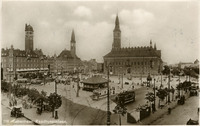 McCarthy Album 08, Photograph 109
McCarthy Album 08, Photograph 109 Caption: "119. Kobenhavn, Raadhuspladsen." This postcard shows a view of Copenhagen, Denmark. It was sent to William and Grace McCarthy on May 12, 1915, from Copenhagen.
-
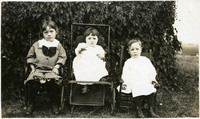 McCarthy Album 08, Photograph 108
McCarthy Album 08, Photograph 108 No Caption: c. 1905. Three unidentified children posing in chairs in a garden or park.
-
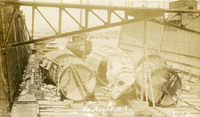 McCarthy Album 08, Photograph 107
McCarthy Album 08, Photograph 107 No Caption: View of what appear to be some type of shipping container, possibly in a dry dock.
-
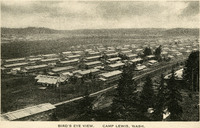 McCarthy Album 08, Photograph 106
McCarthy Album 08, Photograph 106 Caption: "Bird's Eye View. Camp Lewis, Wash.," c. 1918. This postcard shows a bird's eye view of buildings at Camp Lewis. The Camp was established by the U.S. Army in 1917, as part of the U.S.'s preparations for eventual entry into World War I. Rapid construction had the camp ready to house 60,000 men within a few months. The site is still in use as a military facility, under the name Fort Lewis.
-
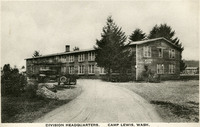 McCarthy Album 08, Photograph 105
McCarthy Album 08, Photograph 105 Caption: "Division Headquarters. Camp Lewis, Wash.," c. 1918. Shows the two-story building that served as Division Headquarters for Camp Lewis in Washington. The Camp was established by the U.S. Army in 1917, as part of the U.S.'s preparations for eventual entry into World War I. Rapid construction had the camp ready to house 60,000 men within a few months. The site is still in use as a military facility, under the name Fort Lewis.
-
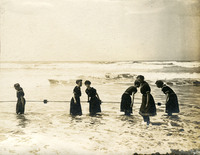 McCarthy Album 08, Photograph 104
McCarthy Album 08, Photograph 104 No Caption: c. 1910. Shows a group of six women playing in the surf at a beach near Seaside, Oregon.
-
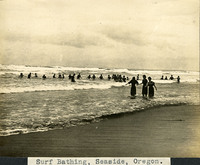 McCarthy Album 08, Photograph 103
McCarthy Album 08, Photograph 103 Caption: "Surf Bathing, Seaside, Oregon.," c. 1910. Beach scene with groups of people playing in the surf at Seaside, Oregon.
-
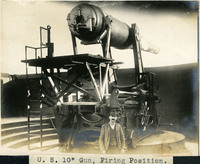 McCarthy Album 08, Photograph 102
McCarthy Album 08, Photograph 102 Caption: "U. S. 10" Gun, Firing Position.," c. 1905. William McCarthy standing next to a 10" disappearing gun, raised to its firing position. Retracting or disappearing guns were a form of artillery developed in the nineteenth century in which heavy artillery guns were placed on rotating carriages that allowed retraction of the weapon after firing, to enable reloading while under enemy fire.
-
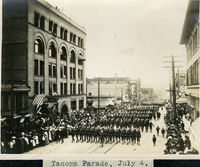 McCarthy Album 08, Photograph 101
McCarthy Album 08, Photograph 101 Caption: "Tacoma Parade, July 4.," c. 1905. View of an Independence Day parade in Tacoma, Washington, showing ranks of marching soldiers.
-
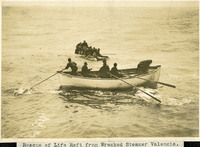 McCarthy Album 08, Photograph 100
McCarthy Album 08, Photograph 100 Caption: "Rescue of Life Raft from Wrecked Steamer Valencia." Photograph showing a boat crew about to rescue 18 people on a life raft. On Monday, January 22, 1906, the passenger liner Valencia ran aground on a reef during a storm off the southwestern coast of Vancouver Island (an area notorious for ship wrecks). Although the shore was only about fifty yards away, heavy seas and rock cliffs prevented the passengers and crew from making their way safely to land. Circumstances prevented rescue vessels from coming to the stricken ship's aid until Wednesday January 24th. The steamship City of Topeka rescued 18 men on a life raft, shown in this photograph. The official death toll was 136: seven officers, 33 crewmen, and 96 passengers (including seventeen women and eleven children -- all of the women and children on board perished). Only 37 people survived the wreck.
-
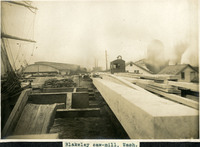 McCarthy Album 08, Photograph 099
McCarthy Album 08, Photograph 099 Caption: "Blakeley saw-mill, Wash.," c. 1905. View of a saw mill in Port Blakeley, now known as Port Blakely, on the southern tip of Bainbridge Island in Puget Sound.
-
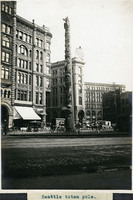 McCarthy Album 08, Photograph 098
McCarthy Album 08, Photograph 098 Caption: "Seattle totem pole.," c. 1905. View of the Tlingit totem pole in Seattle's Pioneer Square. The totem pole was stolen in 1899 by a group of businessmen, and erected in the square, then known as Pioneer Place. An arson destroyed this pole in 1938, but it was later replaced by another carved by the Tlingit tribe (who were also finally paid for the original pole).
-
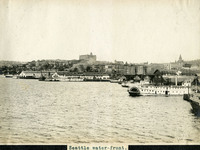 McCarthy Album 08, Photograph 097
McCarthy Album 08, Photograph 097 Caption: "Seattle water-front," c. 1905. View of Seattle's waterfront, as seen from Puget Sound. The Washington Hotel overlooks the city from atop Denny Hill in the center distance, built in the 1890s but destroyed in 1906 when the hill was regraded.
-
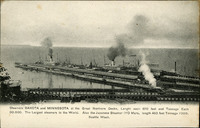 McCarthy Album 08, Photograph 096
McCarthy Album 08, Photograph 096 Caption: "Steamers DAKOTA and MINNESOTA at the Great Northern Docks, Length each 670 feet and Tonnage Each 30,000. The Largest steamers in the World. Also the Japanese Steamer IYO Maru, length 460 feet Tonnage 7000. Seattle Wash.," c. 1905. This postcard shows a view of wharf facilities at Seattle, with three steamships and a train.
-
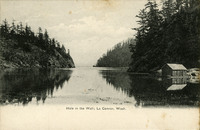 McCarthy Album 08, Photograph 095
McCarthy Album 08, Photograph 095 Caption: "Hole in the Wall; La Conner, Wash.," c. 1905. This postcard shows a view of the "Hole in the Wall," a narrow gap between Puget Sound's Swinomish Channel and Skagit Bay, near La Conner, Washington.
-
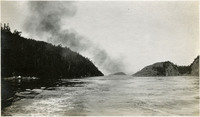 McCarthy Album 08, Photograph 094
McCarthy Album 08, Photograph 094 No Caption: c. 1909. View of the strait known as Deception Pass, separating Whidbey Island from Fidalgo Island in Puget Sound. Deception Island can be seen in the center of the photograph in the distance. See also 96-07-08-alb08-094.
-
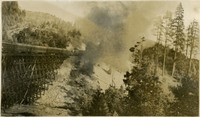 McCarthy Album 08, Photograph 093
McCarthy Album 08, Photograph 093 No Caption: c. 1910. Train crossing trestle in Siskiyou Mountains in northern California or southern Oregon. Smoke obscures the forward cars of the train, presumably from the locomotive. See also 96-07-08-alb05-184.
-
 McCarthy Album 08, Photograph 092
McCarthy Album 08, Photograph 092 No Caption: c. 1915. Street scene on Washington Street in Portland, Oregon, with an electric trolley, automobiles, and pedestrians. See also 96-07-08-alb05-181.
-
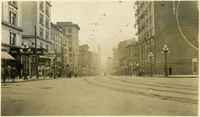 McCarthy Album 08, Photograph 091
McCarthy Album 08, Photograph 091 No Caption: c. 1915. Street scene showing Seattle's Second Avenue. Electric streetcars and the Smith Tower can be seen in the distance. See also 96-07-08-alb05-233.
-
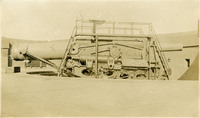 McCarthy Album 08, Photograph 090
McCarthy Album 08, Photograph 090 No Caption: c. 1908-1912. Side view of a disappearing coastal artillery gun. Retracting or disappearing guns were a form of artillery developed in the nineteenth century in which heavy artillery guns were placed on rotating carriages that allowed retraction of the weapon after firing, to enable reloading while under enemy fire.
-
 McCarthy Album 08, Photograph 089
McCarthy Album 08, Photograph 089 Caption: "Sea Coast Guns.," c. 1908-1912. View of a disappearing coastal defense gun, with its carriage. Retracting or disappearing guns were a form of artillery developed in the nineteenth century in which heavy artillery guns were placed on rotating carriages that allowed retraction of the weapon after firing, to enable reloading while under enemy fire.
-
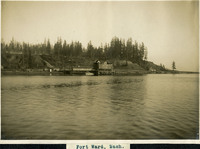 McCarthy Album 08, Photograph 088
McCarthy Album 08, Photograph 088 Caption: "Fort Ward, Wash.," c. 1908-1912. View from Puget Sound of a wharf and other buildings of Fort Ward. Originally known as Bean Point, Fort Ward was established by the U.S. Army Coastal Artillery Corps in 1890. Re-named Fort Ward in 1903, the facility included four coastal batteries designed to assist in protecting Puget Sound and the nearby Naval Shipyard from enemy attack. Fort Ward was placed on inactive status in the 1920s, but was revived by the U.S. Navy during World War II. The Navy discovered the fort's location was ideal for listening to radio communications from Japan, and it subsequently became a top secret listening post with a link directly to Washington, D.C. The Navy continued the fort's use as a listening post until 1956, when it was again taken over by the U.S. Army. The Army subsequently stopped all activity in 1958, ultimately selling portions of the fort to the Washington State Park System in 1960. It is now a state park.
-
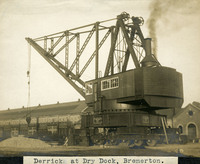 McCarthy Album 08, Photograph 087
McCarthy Album 08, Photograph 087 Caption: "Derrick at Dry Dock, Bremerton.," c. 1908-1912. View of a large derrick (a crane with a pivoting arm) at the Puget Sound Naval Shipyard dry-dock facilities in Bremerton, Washington.
-
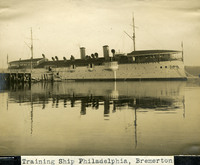 McCarthy Album 08, Photograph 086
McCarthy Album 08, Photograph 086 Caption: "Training Ship Philadelphia, Bremerton," c. 1908-1912. View of the USS Philadelphia (C-4). The fourth ship to bear the name, the Philadelphia first launched in September 1889. She sailed as part of the U.S. Navy's Atlantic Squadron until 1893. She then sailed into the Pacific Ocean, where she served until being decommissioned and docked in Puget Sound in 1902. In 1904, the Navy "housed over" the ship (adding the roofed quarters visible on the upper deck in the photograph) and designated her a receiving ship for new sailors not yet assigned to a crew. The Philadelphia served in this capacity until 1912. After a brief stint as a prison ship, the Philadelphia again became a receiving ship in 1916. The Navy sold her in 1927.
-
 McCarthy Album 08, Photograph 085
McCarthy Album 08, Photograph 085 Caption: "Dry dock, Bremerton.," c. 1908-1912. View of a dry dock at the Puget Sound Naval Shipyard in Bremerton, Washington. Established in 1891 as a naval station, it became Naval Yard Puget Sound in 1901. During World War I the shipyard constructed hundreds of ships to support the war effort, while in World War II, the shipyard was dedicated primarily to repairing damaged ships. Today, it contains a portion of the U.S. Navy's mothball fleet (ships retired but retained in case of future need), as well as building, repairing, and maintaining sea-going vessels of all kinds.
-
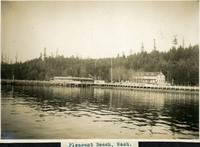 McCarthy Album 08, Photograph 084
McCarthy Album 08, Photograph 084 Caption: "Pleasant Beach, Wash.," c. 1908-1912. View from across a bay in Puget Sound, looking toward the Pleasant Beach Hotel. Built before the turn of the twentieth century, this resort hotel featured forty rooms, a bowling alley, billiards room, swimming pool, and a pavilion. The resort came to be known as the "Coney Island" of Puget Sound.
-
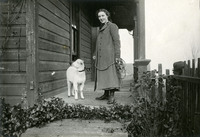 McCarthy Album 08, Photograph 083
McCarthy Album 08, Photograph 083 No Caption: c. 1910. Unidentified young woman standing on a porch with a pet lamb on a leash.
-
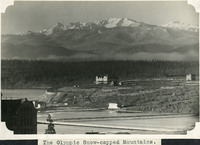 McCarthy Album 08, Photograph 082
McCarthy Album 08, Photograph 082 Caption: "The Olympic Snow-capped Mountains.," c. 1908-1912. Vista of the Olympic Mountains in the distance. In the middle distance to the right can be seen the Eisenbeis Castle (now known as the Manresa Castle Restaurant and Lounge), built in 1892 by Charles Eisenbeis, a businessman and Port Townsend's first mayor. The photograph is centered around what appears to be a resort hotel situated a short distance from the Eisenbeis Castle. See also 96-07-08-alb02-058.
-
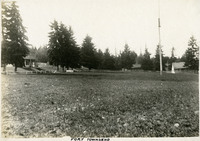 McCarthy Album 08, Photograph 081
McCarthy Album 08, Photograph 081 Caption: "Fort Townsend," c. 1906. Park-like scene, with buildings in the distance and a flag pole at the right. The U.S. Army established Fort Townsend in 1856. Abandoned after a fire destroyed the barracks buildings in 1895, it was reactivated during World War II to serve as a munitions defusing station. It was turned over to the State of Washington in 1953, and is now in use as Fort Townsend State Park.
-
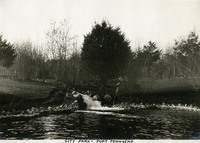 McCarthy Album 08, Photograph 080
McCarthy Album 08, Photograph 080 Caption: "City Park -- Port Townsend," c. 1906. Park scene, possibly in autumn or winter, with a stream cascading down into a small pond or lake.
-
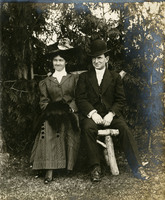 McCarthy Album 08, Photograph 079
McCarthy Album 08, Photograph 079 No Caption: c. 1906. William and Grace McCarthy seated on a wood branch bench in a park or garden.
-
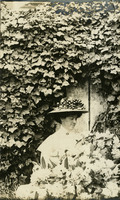 McCarthy Album 08, Photograph 078
McCarthy Album 08, Photograph 078 No Caption: c. 1910. Grace McCarthy kneeling in a garden, looking down at flowers.
-
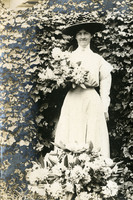 McCarthy Album 08, Photograph 077
McCarthy Album 08, Photograph 077 No Caption: c. 1910. Grace McCarthy posing in a garden with an armful of flowers.
-
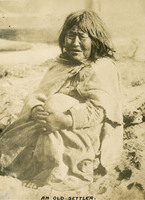 McCarthy Album 08, Photograph 076
McCarthy Album 08, Photograph 076 Caption: "An Old Settler.," undated. Shows an unidentified elderly woman, possibly Native American in ethnicity.
 McCarthy Album 08, Photograph 123 No Caption: View of the Government Building, neighboring buildings, and Geyser Basin at the Alaska-Yukon-Pacific Exposition. Held in Seattle to celebrate the development of the Pacific Northwest, the fair attracted 3.7 million visitors over the course of its run from June to October 1909. Although most of the fair's buildings have since been destroyed, several of them now serve as part of the University of Washington campus. For instance, Geyser Basin became Drumheller Fountain, now at a slightly different location.
McCarthy Album 08, Photograph 123 No Caption: View of the Government Building, neighboring buildings, and Geyser Basin at the Alaska-Yukon-Pacific Exposition. Held in Seattle to celebrate the development of the Pacific Northwest, the fair attracted 3.7 million visitors over the course of its run from June to October 1909. Although most of the fair's buildings have since been destroyed, several of them now serve as part of the University of Washington campus. For instance, Geyser Basin became Drumheller Fountain, now at a slightly different location. McCarthy Album 08, Photograph 122 No Caption: Entryway to the Alaska-Yukon-Pacific Exposition as seen at night. Held in Seattle to celebrate the development of the Pacific Northwest, the fair attracted 3.7 million visitors over the course of its run from June to October 1909. Although most of the fair's buildings have since been destroyed, several of them now serve as part of the University of Washington campus.
McCarthy Album 08, Photograph 122 No Caption: Entryway to the Alaska-Yukon-Pacific Exposition as seen at night. Held in Seattle to celebrate the development of the Pacific Northwest, the fair attracted 3.7 million visitors over the course of its run from June to October 1909. Although most of the fair's buildings have since been destroyed, several of them now serve as part of the University of Washington campus. McCarthy Album 08, Photograph 121b No Caption: Commemorative U.S. two-cent postage stamp issued for the Alaska-Yukon-Pacific Exposition. The stamp features a portrait of William H. Seward, U.S. Secretary of State (1861-1869), U.S. Senator (1849-1861), and twelfth governor of New York (1839-1842). Seward negotiated the purchase of the Alaskan territory from Russia in 1867.
McCarthy Album 08, Photograph 121b No Caption: Commemorative U.S. two-cent postage stamp issued for the Alaska-Yukon-Pacific Exposition. The stamp features a portrait of William H. Seward, U.S. Secretary of State (1861-1869), U.S. Senator (1849-1861), and twelfth governor of New York (1839-1842). Seward negotiated the purchase of the Alaskan territory from Russia in 1867. McCarthy Album 08, Photograph 121a No Caption: Yellow ribbon commemorating "San Francisco Day" at the Alaska-Yukon-Pacific Exposition. Held in Seattle to celebrate the development of the Pacific Northwest, the fair attracted 3.7 million visitors over the course of its run from June to October 1909. Although most of the fair's buildings have since been destroyed, several of them now serve as part of the University of Washington campus.
McCarthy Album 08, Photograph 121a No Caption: Yellow ribbon commemorating "San Francisco Day" at the Alaska-Yukon-Pacific Exposition. Held in Seattle to celebrate the development of the Pacific Northwest, the fair attracted 3.7 million visitors over the course of its run from June to October 1909. Although most of the fair's buildings have since been destroyed, several of them now serve as part of the University of Washington campus. McCarthy Album 08, Photograph 121 No Caption: View of the entryway to the Alaska-Yukon-Pacific Exposition. Held in Seattle to celebrate the development of the Pacific Northwest, the fair attracted 3.7 million visitors over the course of its run from June to October 1909. Although most of the fair's buildings have since been destroyed, several of them now serve as part of the University of Washington campus.
McCarthy Album 08, Photograph 121 No Caption: View of the entryway to the Alaska-Yukon-Pacific Exposition. Held in Seattle to celebrate the development of the Pacific Northwest, the fair attracted 3.7 million visitors over the course of its run from June to October 1909. Although most of the fair's buildings have since been destroyed, several of them now serve as part of the University of Washington campus. McCarthy Album 08, Photograph 120 Caption: "Fair Grounds in 1904, Portland, Or." Bird's eye view of the fair grounds in Portland, Oregon.
McCarthy Album 08, Photograph 120 Caption: "Fair Grounds in 1904, Portland, Or." Bird's eye view of the fair grounds in Portland, Oregon. McCarthy Album 08, Photograph 119 Caption: "Rocky Beach, Sea Side, Oregon.," undated. View of a rocky cliff along a beach in Oregon, with a tunnel carved out by wave action and rubble at the base of the cliff.
McCarthy Album 08, Photograph 119 Caption: "Rocky Beach, Sea Side, Oregon.," undated. View of a rocky cliff along a beach in Oregon, with a tunnel carved out by wave action and rubble at the base of the cliff. McCarthy Album 08, Photograph 118 Caption: "Sea Side, Oregon.," undated. View of a beach along the Oregon coastline, with a rocky cliffs and ocean waves breaking.
McCarthy Album 08, Photograph 118 Caption: "Sea Side, Oregon.," undated. View of a beach along the Oregon coastline, with a rocky cliffs and ocean waves breaking. McCarthy Album 08, Photograph 117 Caption: "U.S. 10" Gun Dismounted.," c. 1905. View from the side of a 10" disappearing gun, a heavy coastal artillery weapon. It has been dismounted from its carriage, with one end held up by timbers. An unidentified man is seated near the barrel of the gun.
McCarthy Album 08, Photograph 117 Caption: "U.S. 10" Gun Dismounted.," c. 1905. View from the side of a 10" disappearing gun, a heavy coastal artillery weapon. It has been dismounted from its carriage, with one end held up by timbers. An unidentified man is seated near the barrel of the gun. McCarthy Album 08, Photograph 116 Caption: "Columbia River Jetty, Or.," c. 1905. View of a dilapidated jetty that once carried railroad tracks. Portions of the jetty appear to have been destroyed or washed away.
McCarthy Album 08, Photograph 116 Caption: "Columbia River Jetty, Or.," c. 1905. View of a dilapidated jetty that once carried railroad tracks. Portions of the jetty appear to have been destroyed or washed away. McCarthy Album 08, Photograph 115 Caption: "Flavel Hotel, Columbia River, Or.," c. 1909. Built at the turn of the century, the Flavel Hotel housed passengers waiting to board steamships of the Great Northern Pacific Steamship Company bound for San Francisco and other ports. The Flavel family constructed the hotel as part of an effort to establish the town of Flavel on Tansy Point along the Columbia River. The town failed to attract sufficient residents, however, and was annexed into Warrenton by 1918. By the time this photograph was taken, the hotel appears to have been abandoned.
McCarthy Album 08, Photograph 115 Caption: "Flavel Hotel, Columbia River, Or.," c. 1909. Built at the turn of the century, the Flavel Hotel housed passengers waiting to board steamships of the Great Northern Pacific Steamship Company bound for San Francisco and other ports. The Flavel family constructed the hotel as part of an effort to establish the town of Flavel on Tansy Point along the Columbia River. The town failed to attract sufficient residents, however, and was annexed into Warrenton by 1918. By the time this photograph was taken, the hotel appears to have been abandoned. McCarthy Album 08, Photograph 114 Caption: "Ferry Boat Tacoma on the Columbia River.," c. 1905. View of the railroad ferry Tacoma, with a train on board. The Tacoma operated from 1884 until 1908, when a railroad bridge was constructed across the Columbia connecting Portland, Oregon with points north of the river.
McCarthy Album 08, Photograph 114 Caption: "Ferry Boat Tacoma on the Columbia River.," c. 1905. View of the railroad ferry Tacoma, with a train on board. The Tacoma operated from 1884 until 1908, when a railroad bridge was constructed across the Columbia connecting Portland, Oregon with points north of the river. McCarthy Album 08, Photograph 113 Caption: "Moonlight on the Columbia River, Oregon.," c. 1905. Photograph of the Columbia River at night. A cloudy sky nearly obscures the moon, but allows enough light to see a three-masted schooner and a small sailboat on the river.
McCarthy Album 08, Photograph 113 Caption: "Moonlight on the Columbia River, Oregon.," c. 1905. Photograph of the Columbia River at night. A cloudy sky nearly obscures the moon, but allows enough light to see a three-masted schooner and a small sailboat on the river. McCarthy Album 08, Photograph 112 No Caption: c. 1909. View of the steamship Minnesota II, built in 1903. She was said to be the largest U.S. merchant ship afloat at the time. Operated by the Great Northern Steamship Company, she sailed between the U.S. and markets in Asia until 1915 when she was sold. In 1917 the Minnesota II began operating in the Atlantic between the U.S. and the United Kingdom. The U.S. Navy commissioned her as a troop ship in 1919, changing her name to Troy. She brought over 14,000 U.S. troops home from war-torn Europe. She never resumed active service after this, being scrapped in 1923.
McCarthy Album 08, Photograph 112 No Caption: c. 1909. View of the steamship Minnesota II, built in 1903. She was said to be the largest U.S. merchant ship afloat at the time. Operated by the Great Northern Steamship Company, she sailed between the U.S. and markets in Asia until 1915 when she was sold. In 1917 the Minnesota II began operating in the Atlantic between the U.S. and the United Kingdom. The U.S. Navy commissioned her as a troop ship in 1919, changing her name to Troy. She brought over 14,000 U.S. troops home from war-torn Europe. She never resumed active service after this, being scrapped in 1923. McCarthy Album 08, Photograph 111 Caption: "Steamer Minnesota, Seattle.," c. 1909. View of the steamship Minnesota II, built in 1903. She was said to be the largest U.S. merchant ship afloat at the time. Operated by the Great Northern Steamship Company, she sailed between the U.S. and markets in Asia until 1915. She was sold at that time, and in 1917 began operating in the Atlantic between the U.S. and the United Kingdom. The U.S. Navy commissioned her as a troop ship in 1919, changing her name to Troy. She brought over 14,000 U.S. troops home from war-torn Europe. She never resumed active service after this, being scrapped in 1923. See also 96-07-08-alb08-166.
McCarthy Album 08, Photograph 111 Caption: "Steamer Minnesota, Seattle.," c. 1909. View of the steamship Minnesota II, built in 1903. She was said to be the largest U.S. merchant ship afloat at the time. Operated by the Great Northern Steamship Company, she sailed between the U.S. and markets in Asia until 1915. She was sold at that time, and in 1917 began operating in the Atlantic between the U.S. and the United Kingdom. The U.S. Navy commissioned her as a troop ship in 1919, changing her name to Troy. She brought over 14,000 U.S. troops home from war-torn Europe. She never resumed active service after this, being scrapped in 1923. See also 96-07-08-alb08-166. McCarthy Album 08, Photograph 110 Caption: "Hs. Maj. Kong Christian X. i Flyvemaskine" and "100 Kobenhavn." This postcard shows Denmark's King Christian X in an early biplane. It was sent to William and Grace McCarthy on December 29, 1915.
McCarthy Album 08, Photograph 110 Caption: "Hs. Maj. Kong Christian X. i Flyvemaskine" and "100 Kobenhavn." This postcard shows Denmark's King Christian X in an early biplane. It was sent to William and Grace McCarthy on December 29, 1915. McCarthy Album 08, Photograph 109 Caption: "119. Kobenhavn, Raadhuspladsen." This postcard shows a view of Copenhagen, Denmark. It was sent to William and Grace McCarthy on May 12, 1915, from Copenhagen.
McCarthy Album 08, Photograph 109 Caption: "119. Kobenhavn, Raadhuspladsen." This postcard shows a view of Copenhagen, Denmark. It was sent to William and Grace McCarthy on May 12, 1915, from Copenhagen. McCarthy Album 08, Photograph 108 No Caption: c. 1905. Three unidentified children posing in chairs in a garden or park.
McCarthy Album 08, Photograph 108 No Caption: c. 1905. Three unidentified children posing in chairs in a garden or park. McCarthy Album 08, Photograph 107 No Caption: View of what appear to be some type of shipping container, possibly in a dry dock.
McCarthy Album 08, Photograph 107 No Caption: View of what appear to be some type of shipping container, possibly in a dry dock. McCarthy Album 08, Photograph 106 Caption: "Bird's Eye View. Camp Lewis, Wash.," c. 1918. This postcard shows a bird's eye view of buildings at Camp Lewis. The Camp was established by the U.S. Army in 1917, as part of the U.S.'s preparations for eventual entry into World War I. Rapid construction had the camp ready to house 60,000 men within a few months. The site is still in use as a military facility, under the name Fort Lewis.
McCarthy Album 08, Photograph 106 Caption: "Bird's Eye View. Camp Lewis, Wash.," c. 1918. This postcard shows a bird's eye view of buildings at Camp Lewis. The Camp was established by the U.S. Army in 1917, as part of the U.S.'s preparations for eventual entry into World War I. Rapid construction had the camp ready to house 60,000 men within a few months. The site is still in use as a military facility, under the name Fort Lewis. McCarthy Album 08, Photograph 105 Caption: "Division Headquarters. Camp Lewis, Wash.," c. 1918. Shows the two-story building that served as Division Headquarters for Camp Lewis in Washington. The Camp was established by the U.S. Army in 1917, as part of the U.S.'s preparations for eventual entry into World War I. Rapid construction had the camp ready to house 60,000 men within a few months. The site is still in use as a military facility, under the name Fort Lewis.
McCarthy Album 08, Photograph 105 Caption: "Division Headquarters. Camp Lewis, Wash.," c. 1918. Shows the two-story building that served as Division Headquarters for Camp Lewis in Washington. The Camp was established by the U.S. Army in 1917, as part of the U.S.'s preparations for eventual entry into World War I. Rapid construction had the camp ready to house 60,000 men within a few months. The site is still in use as a military facility, under the name Fort Lewis. McCarthy Album 08, Photograph 104 No Caption: c. 1910. Shows a group of six women playing in the surf at a beach near Seaside, Oregon.
McCarthy Album 08, Photograph 104 No Caption: c. 1910. Shows a group of six women playing in the surf at a beach near Seaside, Oregon. McCarthy Album 08, Photograph 103 Caption: "Surf Bathing, Seaside, Oregon.," c. 1910. Beach scene with groups of people playing in the surf at Seaside, Oregon.
McCarthy Album 08, Photograph 103 Caption: "Surf Bathing, Seaside, Oregon.," c. 1910. Beach scene with groups of people playing in the surf at Seaside, Oregon. McCarthy Album 08, Photograph 102 Caption: "U. S. 10" Gun, Firing Position.," c. 1905. William McCarthy standing next to a 10" disappearing gun, raised to its firing position. Retracting or disappearing guns were a form of artillery developed in the nineteenth century in which heavy artillery guns were placed on rotating carriages that allowed retraction of the weapon after firing, to enable reloading while under enemy fire.
McCarthy Album 08, Photograph 102 Caption: "U. S. 10" Gun, Firing Position.," c. 1905. William McCarthy standing next to a 10" disappearing gun, raised to its firing position. Retracting or disappearing guns were a form of artillery developed in the nineteenth century in which heavy artillery guns were placed on rotating carriages that allowed retraction of the weapon after firing, to enable reloading while under enemy fire. McCarthy Album 08, Photograph 101 Caption: "Tacoma Parade, July 4.," c. 1905. View of an Independence Day parade in Tacoma, Washington, showing ranks of marching soldiers.
McCarthy Album 08, Photograph 101 Caption: "Tacoma Parade, July 4.," c. 1905. View of an Independence Day parade in Tacoma, Washington, showing ranks of marching soldiers. McCarthy Album 08, Photograph 100 Caption: "Rescue of Life Raft from Wrecked Steamer Valencia." Photograph showing a boat crew about to rescue 18 people on a life raft. On Monday, January 22, 1906, the passenger liner Valencia ran aground on a reef during a storm off the southwestern coast of Vancouver Island (an area notorious for ship wrecks). Although the shore was only about fifty yards away, heavy seas and rock cliffs prevented the passengers and crew from making their way safely to land. Circumstances prevented rescue vessels from coming to the stricken ship's aid until Wednesday January 24th. The steamship City of Topeka rescued 18 men on a life raft, shown in this photograph. The official death toll was 136: seven officers, 33 crewmen, and 96 passengers (including seventeen women and eleven children -- all of the women and children on board perished). Only 37 people survived the wreck.
McCarthy Album 08, Photograph 100 Caption: "Rescue of Life Raft from Wrecked Steamer Valencia." Photograph showing a boat crew about to rescue 18 people on a life raft. On Monday, January 22, 1906, the passenger liner Valencia ran aground on a reef during a storm off the southwestern coast of Vancouver Island (an area notorious for ship wrecks). Although the shore was only about fifty yards away, heavy seas and rock cliffs prevented the passengers and crew from making their way safely to land. Circumstances prevented rescue vessels from coming to the stricken ship's aid until Wednesday January 24th. The steamship City of Topeka rescued 18 men on a life raft, shown in this photograph. The official death toll was 136: seven officers, 33 crewmen, and 96 passengers (including seventeen women and eleven children -- all of the women and children on board perished). Only 37 people survived the wreck. McCarthy Album 08, Photograph 099 Caption: "Blakeley saw-mill, Wash.," c. 1905. View of a saw mill in Port Blakeley, now known as Port Blakely, on the southern tip of Bainbridge Island in Puget Sound.
McCarthy Album 08, Photograph 099 Caption: "Blakeley saw-mill, Wash.," c. 1905. View of a saw mill in Port Blakeley, now known as Port Blakely, on the southern tip of Bainbridge Island in Puget Sound. McCarthy Album 08, Photograph 098 Caption: "Seattle totem pole.," c. 1905. View of the Tlingit totem pole in Seattle's Pioneer Square. The totem pole was stolen in 1899 by a group of businessmen, and erected in the square, then known as Pioneer Place. An arson destroyed this pole in 1938, but it was later replaced by another carved by the Tlingit tribe (who were also finally paid for the original pole).
McCarthy Album 08, Photograph 098 Caption: "Seattle totem pole.," c. 1905. View of the Tlingit totem pole in Seattle's Pioneer Square. The totem pole was stolen in 1899 by a group of businessmen, and erected in the square, then known as Pioneer Place. An arson destroyed this pole in 1938, but it was later replaced by another carved by the Tlingit tribe (who were also finally paid for the original pole). McCarthy Album 08, Photograph 097 Caption: "Seattle water-front," c. 1905. View of Seattle's waterfront, as seen from Puget Sound. The Washington Hotel overlooks the city from atop Denny Hill in the center distance, built in the 1890s but destroyed in 1906 when the hill was regraded.
McCarthy Album 08, Photograph 097 Caption: "Seattle water-front," c. 1905. View of Seattle's waterfront, as seen from Puget Sound. The Washington Hotel overlooks the city from atop Denny Hill in the center distance, built in the 1890s but destroyed in 1906 when the hill was regraded. McCarthy Album 08, Photograph 096 Caption: "Steamers DAKOTA and MINNESOTA at the Great Northern Docks, Length each 670 feet and Tonnage Each 30,000. The Largest steamers in the World. Also the Japanese Steamer IYO Maru, length 460 feet Tonnage 7000. Seattle Wash.," c. 1905. This postcard shows a view of wharf facilities at Seattle, with three steamships and a train.
McCarthy Album 08, Photograph 096 Caption: "Steamers DAKOTA and MINNESOTA at the Great Northern Docks, Length each 670 feet and Tonnage Each 30,000. The Largest steamers in the World. Also the Japanese Steamer IYO Maru, length 460 feet Tonnage 7000. Seattle Wash.," c. 1905. This postcard shows a view of wharf facilities at Seattle, with three steamships and a train. McCarthy Album 08, Photograph 095 Caption: "Hole in the Wall; La Conner, Wash.," c. 1905. This postcard shows a view of the "Hole in the Wall," a narrow gap between Puget Sound's Swinomish Channel and Skagit Bay, near La Conner, Washington.
McCarthy Album 08, Photograph 095 Caption: "Hole in the Wall; La Conner, Wash.," c. 1905. This postcard shows a view of the "Hole in the Wall," a narrow gap between Puget Sound's Swinomish Channel and Skagit Bay, near La Conner, Washington. McCarthy Album 08, Photograph 094 No Caption: c. 1909. View of the strait known as Deception Pass, separating Whidbey Island from Fidalgo Island in Puget Sound. Deception Island can be seen in the center of the photograph in the distance. See also 96-07-08-alb08-094.
McCarthy Album 08, Photograph 094 No Caption: c. 1909. View of the strait known as Deception Pass, separating Whidbey Island from Fidalgo Island in Puget Sound. Deception Island can be seen in the center of the photograph in the distance. See also 96-07-08-alb08-094. McCarthy Album 08, Photograph 093 No Caption: c. 1910. Train crossing trestle in Siskiyou Mountains in northern California or southern Oregon. Smoke obscures the forward cars of the train, presumably from the locomotive. See also 96-07-08-alb05-184.
McCarthy Album 08, Photograph 093 No Caption: c. 1910. Train crossing trestle in Siskiyou Mountains in northern California or southern Oregon. Smoke obscures the forward cars of the train, presumably from the locomotive. See also 96-07-08-alb05-184. McCarthy Album 08, Photograph 092 No Caption: c. 1915. Street scene on Washington Street in Portland, Oregon, with an electric trolley, automobiles, and pedestrians. See also 96-07-08-alb05-181.
McCarthy Album 08, Photograph 092 No Caption: c. 1915. Street scene on Washington Street in Portland, Oregon, with an electric trolley, automobiles, and pedestrians. See also 96-07-08-alb05-181. McCarthy Album 08, Photograph 091 No Caption: c. 1915. Street scene showing Seattle's Second Avenue. Electric streetcars and the Smith Tower can be seen in the distance. See also 96-07-08-alb05-233.
McCarthy Album 08, Photograph 091 No Caption: c. 1915. Street scene showing Seattle's Second Avenue. Electric streetcars and the Smith Tower can be seen in the distance. See also 96-07-08-alb05-233. McCarthy Album 08, Photograph 090 No Caption: c. 1908-1912. Side view of a disappearing coastal artillery gun. Retracting or disappearing guns were a form of artillery developed in the nineteenth century in which heavy artillery guns were placed on rotating carriages that allowed retraction of the weapon after firing, to enable reloading while under enemy fire.
McCarthy Album 08, Photograph 090 No Caption: c. 1908-1912. Side view of a disappearing coastal artillery gun. Retracting or disappearing guns were a form of artillery developed in the nineteenth century in which heavy artillery guns were placed on rotating carriages that allowed retraction of the weapon after firing, to enable reloading while under enemy fire. McCarthy Album 08, Photograph 089 Caption: "Sea Coast Guns.," c. 1908-1912. View of a disappearing coastal defense gun, with its carriage. Retracting or disappearing guns were a form of artillery developed in the nineteenth century in which heavy artillery guns were placed on rotating carriages that allowed retraction of the weapon after firing, to enable reloading while under enemy fire.
McCarthy Album 08, Photograph 089 Caption: "Sea Coast Guns.," c. 1908-1912. View of a disappearing coastal defense gun, with its carriage. Retracting or disappearing guns were a form of artillery developed in the nineteenth century in which heavy artillery guns were placed on rotating carriages that allowed retraction of the weapon after firing, to enable reloading while under enemy fire. McCarthy Album 08, Photograph 088 Caption: "Fort Ward, Wash.," c. 1908-1912. View from Puget Sound of a wharf and other buildings of Fort Ward. Originally known as Bean Point, Fort Ward was established by the U.S. Army Coastal Artillery Corps in 1890. Re-named Fort Ward in 1903, the facility included four coastal batteries designed to assist in protecting Puget Sound and the nearby Naval Shipyard from enemy attack. Fort Ward was placed on inactive status in the 1920s, but was revived by the U.S. Navy during World War II. The Navy discovered the fort's location was ideal for listening to radio communications from Japan, and it subsequently became a top secret listening post with a link directly to Washington, D.C. The Navy continued the fort's use as a listening post until 1956, when it was again taken over by the U.S. Army. The Army subsequently stopped all activity in 1958, ultimately selling portions of the fort to the Washington State Park System in 1960. It is now a state park.
McCarthy Album 08, Photograph 088 Caption: "Fort Ward, Wash.," c. 1908-1912. View from Puget Sound of a wharf and other buildings of Fort Ward. Originally known as Bean Point, Fort Ward was established by the U.S. Army Coastal Artillery Corps in 1890. Re-named Fort Ward in 1903, the facility included four coastal batteries designed to assist in protecting Puget Sound and the nearby Naval Shipyard from enemy attack. Fort Ward was placed on inactive status in the 1920s, but was revived by the U.S. Navy during World War II. The Navy discovered the fort's location was ideal for listening to radio communications from Japan, and it subsequently became a top secret listening post with a link directly to Washington, D.C. The Navy continued the fort's use as a listening post until 1956, when it was again taken over by the U.S. Army. The Army subsequently stopped all activity in 1958, ultimately selling portions of the fort to the Washington State Park System in 1960. It is now a state park. McCarthy Album 08, Photograph 087 Caption: "Derrick at Dry Dock, Bremerton.," c. 1908-1912. View of a large derrick (a crane with a pivoting arm) at the Puget Sound Naval Shipyard dry-dock facilities in Bremerton, Washington.
McCarthy Album 08, Photograph 087 Caption: "Derrick at Dry Dock, Bremerton.," c. 1908-1912. View of a large derrick (a crane with a pivoting arm) at the Puget Sound Naval Shipyard dry-dock facilities in Bremerton, Washington. McCarthy Album 08, Photograph 086 Caption: "Training Ship Philadelphia, Bremerton," c. 1908-1912. View of the USS Philadelphia (C-4). The fourth ship to bear the name, the Philadelphia first launched in September 1889. She sailed as part of the U.S. Navy's Atlantic Squadron until 1893. She then sailed into the Pacific Ocean, where she served until being decommissioned and docked in Puget Sound in 1902. In 1904, the Navy "housed over" the ship (adding the roofed quarters visible on the upper deck in the photograph) and designated her a receiving ship for new sailors not yet assigned to a crew. The Philadelphia served in this capacity until 1912. After a brief stint as a prison ship, the Philadelphia again became a receiving ship in 1916. The Navy sold her in 1927.
McCarthy Album 08, Photograph 086 Caption: "Training Ship Philadelphia, Bremerton," c. 1908-1912. View of the USS Philadelphia (C-4). The fourth ship to bear the name, the Philadelphia first launched in September 1889. She sailed as part of the U.S. Navy's Atlantic Squadron until 1893. She then sailed into the Pacific Ocean, where she served until being decommissioned and docked in Puget Sound in 1902. In 1904, the Navy "housed over" the ship (adding the roofed quarters visible on the upper deck in the photograph) and designated her a receiving ship for new sailors not yet assigned to a crew. The Philadelphia served in this capacity until 1912. After a brief stint as a prison ship, the Philadelphia again became a receiving ship in 1916. The Navy sold her in 1927. McCarthy Album 08, Photograph 085 Caption: "Dry dock, Bremerton.," c. 1908-1912. View of a dry dock at the Puget Sound Naval Shipyard in Bremerton, Washington. Established in 1891 as a naval station, it became Naval Yard Puget Sound in 1901. During World War I the shipyard constructed hundreds of ships to support the war effort, while in World War II, the shipyard was dedicated primarily to repairing damaged ships. Today, it contains a portion of the U.S. Navy's mothball fleet (ships retired but retained in case of future need), as well as building, repairing, and maintaining sea-going vessels of all kinds.
McCarthy Album 08, Photograph 085 Caption: "Dry dock, Bremerton.," c. 1908-1912. View of a dry dock at the Puget Sound Naval Shipyard in Bremerton, Washington. Established in 1891 as a naval station, it became Naval Yard Puget Sound in 1901. During World War I the shipyard constructed hundreds of ships to support the war effort, while in World War II, the shipyard was dedicated primarily to repairing damaged ships. Today, it contains a portion of the U.S. Navy's mothball fleet (ships retired but retained in case of future need), as well as building, repairing, and maintaining sea-going vessels of all kinds. McCarthy Album 08, Photograph 084 Caption: "Pleasant Beach, Wash.," c. 1908-1912. View from across a bay in Puget Sound, looking toward the Pleasant Beach Hotel. Built before the turn of the twentieth century, this resort hotel featured forty rooms, a bowling alley, billiards room, swimming pool, and a pavilion. The resort came to be known as the "Coney Island" of Puget Sound.
McCarthy Album 08, Photograph 084 Caption: "Pleasant Beach, Wash.," c. 1908-1912. View from across a bay in Puget Sound, looking toward the Pleasant Beach Hotel. Built before the turn of the twentieth century, this resort hotel featured forty rooms, a bowling alley, billiards room, swimming pool, and a pavilion. The resort came to be known as the "Coney Island" of Puget Sound. McCarthy Album 08, Photograph 083 No Caption: c. 1910. Unidentified young woman standing on a porch with a pet lamb on a leash.
McCarthy Album 08, Photograph 083 No Caption: c. 1910. Unidentified young woman standing on a porch with a pet lamb on a leash. McCarthy Album 08, Photograph 082 Caption: "The Olympic Snow-capped Mountains.," c. 1908-1912. Vista of the Olympic Mountains in the distance. In the middle distance to the right can be seen the Eisenbeis Castle (now known as the Manresa Castle Restaurant and Lounge), built in 1892 by Charles Eisenbeis, a businessman and Port Townsend's first mayor. The photograph is centered around what appears to be a resort hotel situated a short distance from the Eisenbeis Castle. See also 96-07-08-alb02-058.
McCarthy Album 08, Photograph 082 Caption: "The Olympic Snow-capped Mountains.," c. 1908-1912. Vista of the Olympic Mountains in the distance. In the middle distance to the right can be seen the Eisenbeis Castle (now known as the Manresa Castle Restaurant and Lounge), built in 1892 by Charles Eisenbeis, a businessman and Port Townsend's first mayor. The photograph is centered around what appears to be a resort hotel situated a short distance from the Eisenbeis Castle. See also 96-07-08-alb02-058. McCarthy Album 08, Photograph 081 Caption: "Fort Townsend," c. 1906. Park-like scene, with buildings in the distance and a flag pole at the right. The U.S. Army established Fort Townsend in 1856. Abandoned after a fire destroyed the barracks buildings in 1895, it was reactivated during World War II to serve as a munitions defusing station. It was turned over to the State of Washington in 1953, and is now in use as Fort Townsend State Park.
McCarthy Album 08, Photograph 081 Caption: "Fort Townsend," c. 1906. Park-like scene, with buildings in the distance and a flag pole at the right. The U.S. Army established Fort Townsend in 1856. Abandoned after a fire destroyed the barracks buildings in 1895, it was reactivated during World War II to serve as a munitions defusing station. It was turned over to the State of Washington in 1953, and is now in use as Fort Townsend State Park. McCarthy Album 08, Photograph 080 Caption: "City Park -- Port Townsend," c. 1906. Park scene, possibly in autumn or winter, with a stream cascading down into a small pond or lake.
McCarthy Album 08, Photograph 080 Caption: "City Park -- Port Townsend," c. 1906. Park scene, possibly in autumn or winter, with a stream cascading down into a small pond or lake. McCarthy Album 08, Photograph 079 No Caption: c. 1906. William and Grace McCarthy seated on a wood branch bench in a park or garden.
McCarthy Album 08, Photograph 079 No Caption: c. 1906. William and Grace McCarthy seated on a wood branch bench in a park or garden. McCarthy Album 08, Photograph 078 No Caption: c. 1910. Grace McCarthy kneeling in a garden, looking down at flowers.
McCarthy Album 08, Photograph 078 No Caption: c. 1910. Grace McCarthy kneeling in a garden, looking down at flowers. McCarthy Album 08, Photograph 077 No Caption: c. 1910. Grace McCarthy posing in a garden with an armful of flowers.
McCarthy Album 08, Photograph 077 No Caption: c. 1910. Grace McCarthy posing in a garden with an armful of flowers. McCarthy Album 08, Photograph 076 Caption: "An Old Settler.," undated. Shows an unidentified elderly woman, possibly Native American in ethnicity.
McCarthy Album 08, Photograph 076 Caption: "An Old Settler.," undated. Shows an unidentified elderly woman, possibly Native American in ethnicity.